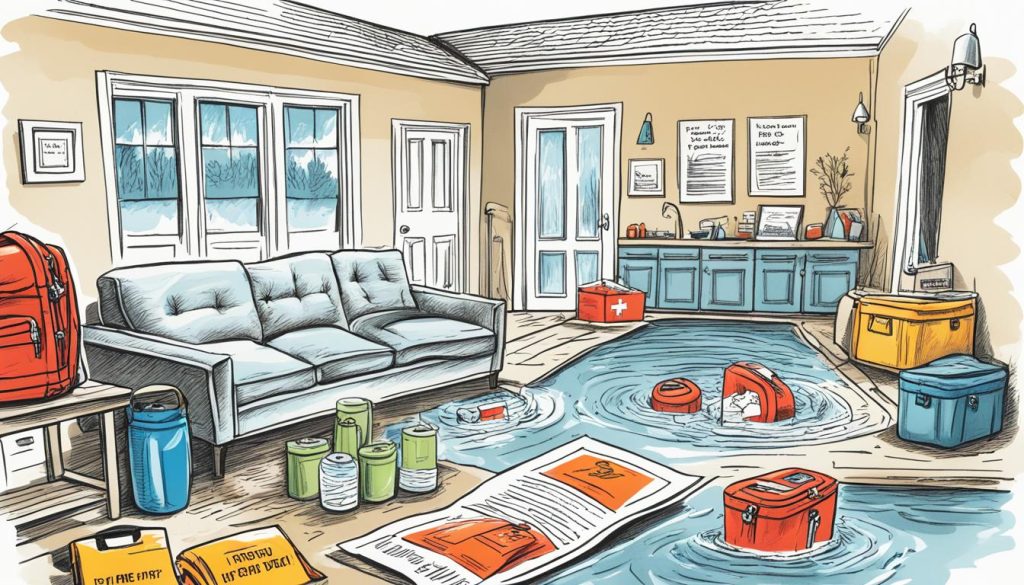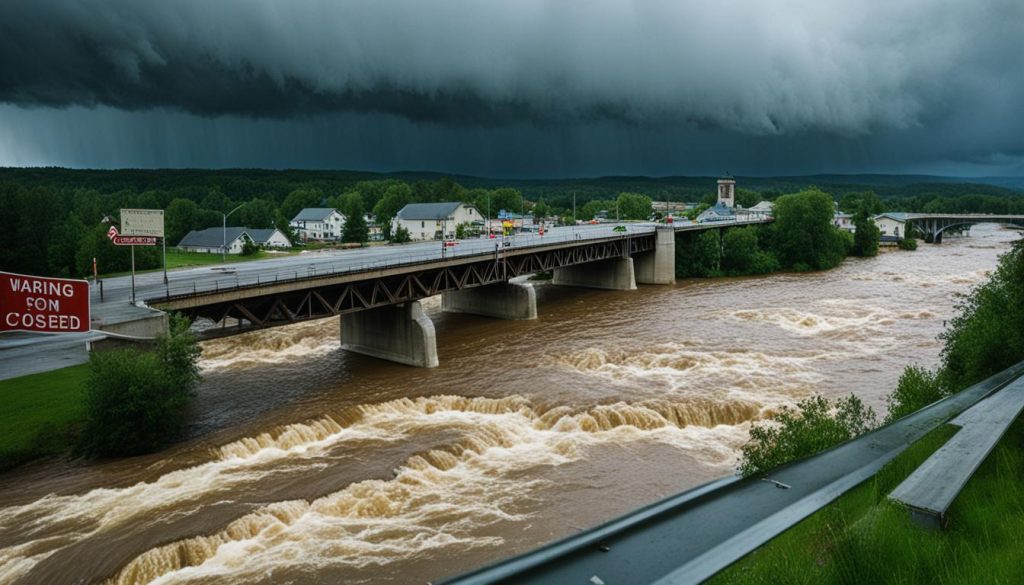Flooding is a common natural disaster in the United States, causing extensive damage and destruction. Did you know that according to the Federal Emergency Management Agency (FEMA), floods are the most common and costly natural disaster in the country? It is essential to take flood preparedness seriously to protect your family and property from potential devastation.
Key Takeaways:
- Floods are the most common and costly natural disaster in the United States.
- Proper flood preparedness can help protect your family and property from potential devastation.
- Understanding flood watches and warnings is crucial for responding effectively to flood events.
- Purchasing flood insurance is an important step in safeguarding your assets.
- Creating a flood preparedness checklist and knowing evacuation routes can help you be ready for a flood.
Understanding Flood Watches and Warnings
It is crucial to understand the difference between a flood watch and a flood warning. Flood watches are issued when conditions are favorable for flooding, but they do not guarantee that flooding will occur. This means that you should stay alert and be prepared to take action if necessary, but immediate evacuation may not be required.
On the other hand, a flood warning is a more urgent situation. It means that flooding is expected or already happening in the affected area. When a flood warning is issued, it is vitally important to take immediate action to protect yourself, your family, and your property.
In both cases, it is essential to be aware of the flood evacuation routes in your area. These routes are carefully planned to guide residents to safe locations away from flood-prone areas. Knowing these routes and having a predetermined plan will help you act quickly and efficiently during an emergency situation.
“A flood watch means be prepared, a flood warning means take action!” – National Weather Service
Preparing for a Flood Warning
If a flood warning is issued in your area, follow these steps:
- Monitor local news and weather updates for the latest information on the situation.
- Take immediate steps to protect yourself and your loved ones. Evacuate to higher ground if instructed to do so.
- Secure your home by unplugging electrical appliances, moving important belongings to higher floors, and turning off utilities if instructed to do so.
- Follow designated evacuation routes and do not attempt to drive or walk through floodwaters.
- Keep emergency supplies, such as food, water, and medication, readily available in case you need to shelter in place.
Remember, your safety is the top priority during a flood warning. Stay informed, follow official instructions, and be prepared to take decisive action to protect yourself and your loved ones.
Steps to Prepare for a Flood
When it comes to flood preparedness, taking proactive measures is crucial in safeguarding your home and loved ones. By following these steps, you can be prepared for a flood and mitigate potential damages.
Evaluate Your Flood Zone
Knowing whether your home is located in a flood zone is the first step in flood preparedness. You can check with your local government or use online resources to determine the flood risk in your area. Understanding your flood zone will help you assess the level of precautionary measures needed.
Purchase Flood Insurance
Flood insurance is a separate policy from your standard homeowner’s insurance. It provides coverage specifically for flood-related damages. Even if you do not live in a high-risk flood zone, purchasing flood insurance is recommended as floods can occur anywhere. Ensure you review the policy details, coverage limits, and exclusions to make an informed decision.
Create a Flood Preparedness Checklist
A comprehensive flood preparedness checklist will help you stay organized and ready in the event of a flood. Consider the following items:
- Emergency supplies kit (including non-perishable food, water, flashlight, and batteries)
- Important documents (stored in waterproof containers or digitally backed up)
- Evacuation plan (identify safe routes, designate meeting points)
- Safeguard valuable items (elevate or move them to a higher floor)
- Secure your property (install flood barriers, clear gutters, and drains)
Stay Informed
Monitor local weather updates and stay informed about any flood watches or warnings in your area. Sign up for emergency alerts through your community’s notification system. Being aware of potential flood risks and staying informed will allow you to take prompt action when necessary.
Consult with Professionals
If you are unsure about any aspect of flood preparedness or require assistance in assessing your property’s vulnerability, consider consulting with flood experts or other professionals. They can provide valuable insights and guidance specific to your situation. Don’t hesitate to reach out to your local emergency management agency for additional resources.
By following these steps and being proactive in your flood preparedness efforts, you can better protect your home, belongings, and loved ones during a flood. Stay vigilant, stay prepared.
| Flood Preparedness Checklist | |
|---|---|
| Emergency supplies kit | Includes non-perishable food, water, flashlight, batteries, and first aid supplies. |
| Important documents | Store in waterproof containers or digitally back them up. |
| Evacuation plan | Identify safe routes and designate meeting points for your family. |
| Safeguard valuable items | Elevate or move to a higher floor to protect them from floodwaters. |
| Secure your property | Install flood barriers, clear gutters, and drains to minimize potential damage. |
What to Do During a Flood
During a flood, the utmost priority is ensuring the safety of yourself and your loved ones. It is important to remember key steps to stay safe and minimize potential risks during such a challenging situation.
Avoid walking or driving through floodwaters: Walking through floodwaters can be extremely hazardous. The water may be deeper than it appears, and there can be strong currents, debris, or even hidden sinkholes. It is crucial to protect yourself and stay out of floodwaters to prevent accidents and injuries.
Stay off bridges over water: Bridges can become unstable or even collapse during a flood. It is essential to avoid crossing bridges over water to ensure personal safety. Seek alternative routes or stay in a safe location until it is safe to travel.
Move to higher ground: If you are in a low-lying area or your home is at risk of flooding, it is crucial to move to higher ground. Seek shelter on the highest level of your home, such as an upper floor or attic, if it is safe to do so. If necessary, evacuate to a pre-determined safe location on higher ground as directed by local authorities.
“During a flood, always prioritize safety and follow the guidance of local authorities. The damage caused by floodwaters can be extensive, and it is important to take necessary precautions to protect yourself and your loved ones.”
Remember, floodwaters can be unpredictable and dangerous. By avoiding walking through floodwaters, staying off bridges over water, and moving to higher ground, you can significantly reduce the risk of harm during a flood.
Additional Tips and Considerations
While understanding flood watches and warnings, purchasing flood insurance, and creating a flood preparedness checklist are crucial steps, there are additional precautions you can take to further enhance your flood preparedness. Here are some important tips and considerations:
Clean Your Gutters
Regularly cleaning out your gutters and ensuring they are free from debris is essential in preventing water damage during a flood. Clogged gutters can lead to water overflowing, increasing the risk of water seeping into your home. Consider installing gutter guards to minimize the buildup of leaves and other debris, maintaining the proper flow of water away from your property.
Move Valuables to Higher Ground
When preparing for a flood, it’s important to move your valuables to higher ground to keep them safe from potential water damage. Consider relocating items such as furniture, electronics, and sentimental possessions to an upper level or elevated area. This proactive measure can help protect your valuables and minimize potential losses.
Protect Important Documents in a Waterproof Container
Another crucial step in flood preparedness is safeguarding your important documents. Store vital paperwork, such as passports, birth certificates, insurance policies, and financial records, in a waterproof container. This will provide an additional layer of protection and ensure these documents remain intact even in the event of water intrusion.
By taking these additional precautions, you can bolster your flood preparedness efforts and minimize potential damage to your property and belongings.
| Tips | Considerations |
|---|---|
| Clean gutters regularly | Check for clogs and install gutter guards |
| Move valuables to higher ground | Consider upper levels or elevated areas |
| Protect important documents | Use a waterproof container |
Conclusion
Flood preparedness is crucial for safeguarding your loved ones and property against the devastating effects of floods. By taking proactive steps such as understanding flood watches and warnings, purchasing flood insurance, and implementing necessary precautions, you can significantly reduce the risks associated with flooding.
Stay informed about your flood risk by conducting a thorough flood risk assessment based on your geographical location and historical data. This assessment will help you better understand the potential hazards and vulnerabilities your property may face during a flood.
Create an emergency flood plan that outlines clear evacuation routes, designated meeting points, and communication strategies. Having a well-prepared plan in place will ensure a swift and organized response in the event of a flood.
Implement effective flood prevention measures, such as installing flood barriers, sealing basements, and elevating important equipment and utilities. These proactive steps can significantly minimize the impact of a flood on your property and belongings.
To learn more about flood preparedness and access additional resources, visit Ready.gov. Remember, taking the time to prepare and mitigate potential risks now can save lives and property in the face of a flood.



